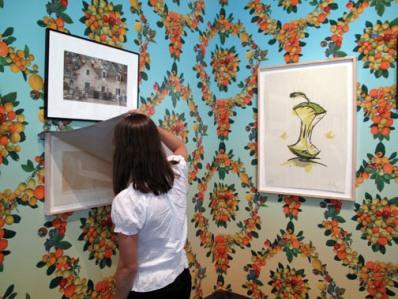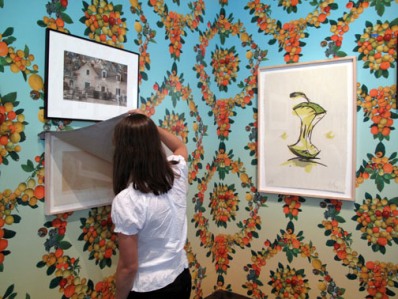Want to find out what’s behind the curtain inside EATLACMA?
Ed Ruscha had been painting single words onto canvas using a trompe l’oieil technique since about 1967. But, as he explained in his catalogue Raisonné, “I felt for awhile there that I was painting pictures. And in painting pictures, I was just applying skin to canvas... There was not enough for me.” In 1969, the Tamarind Lithography Workshop in Hollywood invited Ruscha for a two-month fellowship where he would work with master printers to produce lithographs using the words Anchovy, Mint, and Carp, all looking as if the words were spelled out of spilled liquids. Ruscha took the “spilled liquid” prints a step further when he started experimenting using organic and inorganic materials such as Vaseline petroleum jelly, tobacco, egg yolk, beer, chocolate syrup, wine, Liquid Drano, grass, and even his own blood in work called Stains. It was around this time that his friend and master printer Jean-Milant decided to open up his own shop, Cirrus Editions and Cirrus Gallery. Under Milant, Cirrus welcomed experimentation, and it was here that Ruscha created the two-color screenprint titled Fruit-Metrecal using apricot and grape jams, and a diet drink from the sixties called Metrecal.

Edward Ruscha, "Fruit-Metrecal Hollywood," 1971, Cirrus Editions Archive, purchased with funds provided by the Director's Roundtable, and gift of Cirrus Editions
I talked to Chail Norton, assistant paper conservator, to find out why it needed to stay behind a curtain. LACMA conservators did some highly technical “fadeometer” readings within the last few years to find out just how quickly the colorants will fade. They determined that since the piece is comprised of organic materials it is highly light sensitive, and will fade easily.
The Hollywood sign was not a new subject for Ruscha; he often uses the visual language of Los Angeles in his work. In 1986, LACMA acquired the Cirrus Collection, which included a similar piece, using Pepto Bismol and Caviar. Pepto-Caviar Hollywood will be on view at the Norton Simon later this year.

Edward Ruscha, "Pepto-Caviar Hollywood," 1970, Cirrus Editions Archive, purchased with funds provided by the Director's Roundtable, and gift of Cirrus Editions




